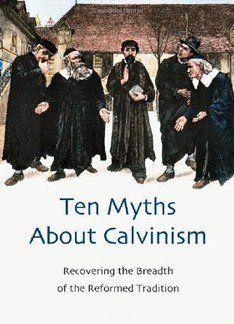The main title, ‘Ten Myths About Calvinism’, suggests a strident volume in which opposing views will be given short shrift. In fact, this is a balanced and scholarly work, though accessible to the general reader.
The book is organised into two parts. Part one deals with ‘Four Myths Calvinists Should Not Be Circulating (But Are)’. These are: One Man (Calvin) and One City (Geneva) Are Determinative, Calvin’s View of Predestination Must be Ours, TULIP is the Yardstick of the Truly Reformed, and Calvinists Take a Dim View of Revival.
In chapter one, emphasis is placed on the plurality of Reformation leaders such as Bullinger, Zwingli, and Peter Martyr, and of places such as Zurich, Basel and Strasbourg. The pre-eminence of Calvin is reckoned a nineteenth century phenomenon, associated with Romanticism and the decision of one Henry Drummond to finance the reprinting of ‘The Institutes’. While this is interesting historically, it’s unlikely to convince those who see God’s providence behind the wide dissemination of Calvin’s great work. The author perhaps could have interacted with the view of scholar Philip Benedict that Calvin, ‘unquestionably merits the leading role traditionally assigned him’. Likewise in the TULIP chapter, where the acrostic is again said to be a late and unsatisfactory development, Lorraine Boettner could have been more extensively dealt with rather than footnoted.
Part Two is on the face of it more likely to appeal to staunch Calvinists, with its ‘Six Myths Non-Calvinists Should Not Be Circulating (But Are)’, which comprise: Calvinism is Largely Antimissionary, Calvinism Promotes Antinomianism, Calvinism Leads to Theocracy, Calvinism Undermines the Creative Arts, Calvinism Resists Gender Equality, and Calvinism Has Fostered Racial Inequality. Chapter five should appeal to many, and the remaining chapters adopt strategies of showing that just because Calvinism has been associated with questionable practices, this does not mean it has caused them, or that Calvinism is no more tainted than any other tradition.
The chapter on the arts admits varying degrees of iconoclasm, but shows how the Reformation began to support a new kind of art as it developed, although more could be said about our current situation regarding the arts.
On women, we are told Calvin approved of women deacons for distributing alms, and are introduced to various ‘church mothers’.
The book is well written and purposeful in its explicit aim of ‘Recovering Our Bearings’. While some will find it controversial, it is a thought provoking volume.
Anthony Oughton,
Gateshead









